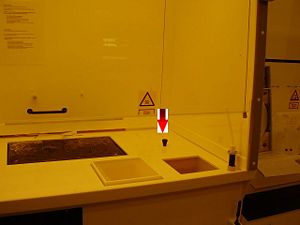Specific Process Knowledge/Etch/Wet Titanium Etch: Difference between revisions
No edit summary |
|||
| Line 34: | Line 34: | ||
|-style="background:LightGrey; color:black" | |-style="background:LightGrey; color:black" | ||
|'''Link to safety APV and KBA''' | |'''Link to safety APV and KBA''' | ||
|[http:// | |[http://labmanager.danchip.dtu.dk/d4Show.php?id=2479&mach=146 see APV here] | ||
[http://kemibrug.dk/KBA/CAS/106534/?show_KBA=1&portaldesign=1 see KBA here] | [http://kemibrug.dk/KBA/CAS/106534/?show_KBA=1&portaldesign=1 see KBA here] | ||
|[http:// | |[http://labmanager.danchip.dtu.dk/d4Show.php?id=2479&mach=146 see APV here] | ||
|- | |- | ||
Revision as of 14:33, 4 September 2013
Feedback to this page: click here
Ething of Titanium can be done either wet or dry. For wet etching please see below on this page. Dry etching can be done either with ICP using Chlorine chemistry or with IBE by sputtering with Ar ions.
Wet etching of Titanium

Wet Etch of Titanium can take place in this pp tank or in a beaker in this fume hood
We have two solutions for wet titanium etching:
- BHF
- Cold RCA1
Do it by making your own set up in a beaker in a fume hood - preferably in cleanroom 2 or 4. BHF etching can also take place in the PP-etch bath in the fume hood in cleanroom 2.
Comparing the two solutions
| BHF | Cold RCA1 | |
|---|---|---|
| General description | Etch of titanium with or without photoresist mask. | Etch of titanium (as stripper or with eagle resist). |
| Link to safety APV and KBA | see APV here | see APV here |
| Chemical solution | HF:NH4F | NH3OH:H2O2:H2O - 1:1:5 |
| Process temperature | Room temperature | Room temperature |
| Possible masking materials |
Photoresist (1.5 µm AZ5214E) |
Eagle resist |
| Etch rate |
Not known (it bubbles while etching) |
Not known |
| Batch size |
1-5 4" in beaker 1-25 wafers at a time in PP-etch bath |
1-5 4" wafer at a time |
| Etch bath | Beaker or PP-etch bath in the fume hood in cleanroom 2. | Beaker |
| Allowed materials |
No restrictions when used in beaker or PP-etch bath in the fume hood in cleanroom 2. Make a note on the beaker of which materials have been processed. |
No restrictions when used in beaker. Make a note on the beaker of which materials have been processed. |
